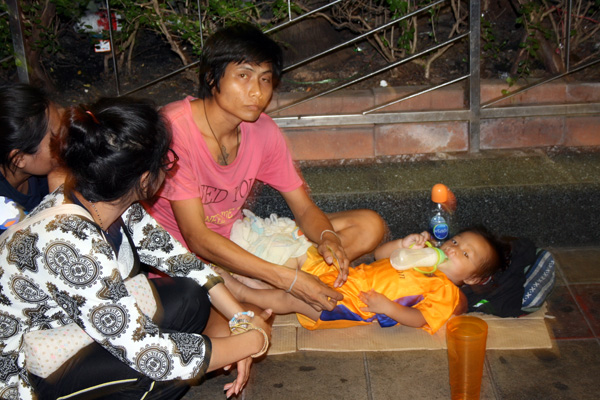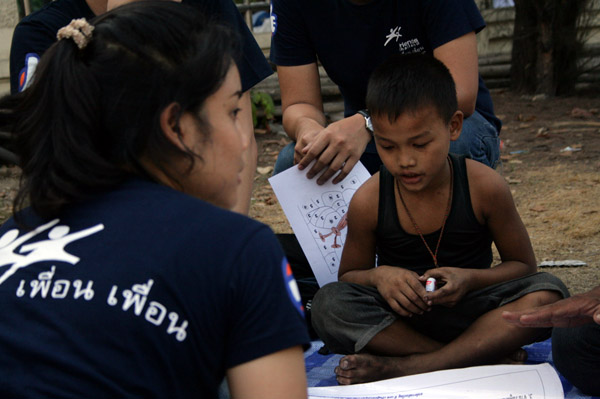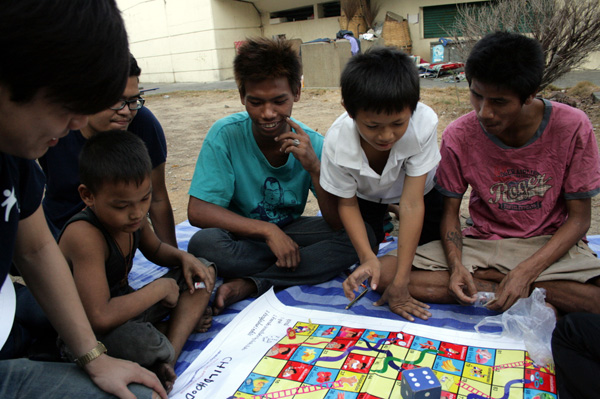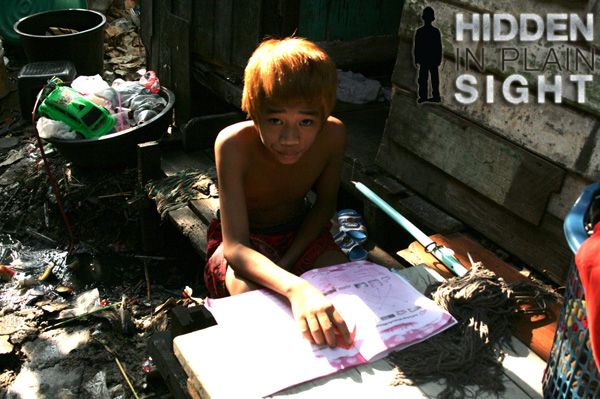
Somewhere amid the splendor and squalor of gilded shopping malls and destitute slums, Bangkok’s invisible children are exploited for labor, sex and criminal enterprise. Coconuts Bangkok wanted to find out more about who they are, where they come from and how they end up on the streets. “Hidden in Plain Sight” is a series of stories which seek to share what we learned in hopes of increasing awareness and compelling action. This is the first installment. ABOVE: Chun, 13, lives in a squatter camp with his family. He quit school this year to work the streets to support his large family.
HIDDEN IN PLAIN SIGHT — Chun is a lanky boy with skinny legs, a round face, and docile eyes that defy the brashness of his bleached-orange hair. The 13-year-old boy sits in a narrow alley outside his house, wearing only a baggy pair of red shorts and listening blankly to the nasal cackles of his neighbor, an overweight woman with more than a few missing teeth. She is relaying the gossip of western Bangkok’s 300-person Suksanari slum, an informal squatter community on the Thonburi side of the Chao Phraya River crammed wall-to-wall with sheet metal, caged chickens and piles of garbage swarmed by flies.
READ: Part 2 – Escaping abuse for torments of the street, Bangkok’s homeless youth can’t get a break
His teenage sister, sitting next to the neighbor, casually slaps at the flies that land on her legs, which are already scarred with brown, pox-like marks from the insects and bacteria that come with living amidst mud, stagnant puddles and rotten garbage.
But the insects are the least of the families’ worries.
With no income to support her 10 children, Chun’s mother routinely takes the youngest ones begging near the gilded shopping malls and tourist haunts of the Nana and Asoke areas. In February, Chun stopped going to school. “I left because my friends also did,” he said softly while looking away, ashamed.
Chun and his sister are among 30,000 minors in Thailand who beg in the streets to earn money for others at the expense of their futures, fueling exploitation that robs them of childhood and exposes them to abuse and potential damage for the rest of their lives – if they survive.

Most families in Chun’s community are from upcountry provinces – northern and northeastern rural areas where during the harvest season they live day-to-day off meager wages for manual labor – harvesting rice, corn and sugar cane – taking home no more than THB150 baht by each nightfall.
But during the off-season, without work, desperation drives them onto buses, minivans and trains to Bangkok in search of a means to survive.
While the more industrious ones make a living selling tamarind and beans from street stalls, the poorer members beg along the tourist-heavy haunts of Sukhumvit Road, sell their bodies in Nana and Asoke, or make flowers for their little ones to sell to motorists stopped in traffic.
“Most of these parents realize that an education will provide their children with a better future, but the daily economic needs of the family push their children out of school and onto the streets to work,” said Tim Tempany, the Technical Advisor for the Thailand program of Friends-International, an international, Cambodia-based NGO that has worked with Bangkok’s street children since 2006. Friends offers vocational training to older street dwellers and plans to open a restaurant to employ youth by the end of 2014.

An estimated 30,000 children live and/or work on the streets in Thailand, according to research by the Life Children Foundation, a local charity focused on child welfare.
The economic expansion of the past decade has primarily benefited urban centers, so now the grimy inner-city streets of Bangkok draw in bereft, cash-starved Cambodians (60 percent of the child street beggars) and Thais from other parts of the country (40 percent).
Contrary to popular belief, the begging profession is relatively profitable. While in Cambodia, the average daily wage of a non-maimed beggar is a few hundred riel – roughly THB2 – in Thailand children under 10 often earn double the minimum daily wage of THB300.
This creates a vigorous market for panhandling and illegal migration.
Cambodian children as young as infants are pulled away from homes and schools to work the streets of Bangkok, where the average daily wage is about THB100 (US$3) to spend their days and nights sharing pavement with sex workers and sex tourists.
The children are vulnerable to physical and sexual abuse, illness, disease, drug addiction and traffic accidents. Without an education, their prospects for the future are limited to potentially exploitative labor – work in the notoriously dangerous and informal sex, construction or fishing industries – or even worse, they become involved in criminal activities or drug dealing.
Bangkok’s invisible street faces
The begging children sit on street corners, at the bottom of BTS station stairs, with matted hair and grime-blackened clothes, often sleeping with hands folded in a traditional wai while before them, a plastic cup beckons passers-by. For all the tragedy of their situation, their constant presence places them beyond notice to many, as much a part of Bangkok’s public scenery as street food stalls, orange-vested motorbike taxis and mobile fruit carts.
“The public visibility of beggars is in direct contradiction to the dearth of information available about their lives,” Friends reported in 2006 . Eight years later, not much has changed, but the NGOs working with the children are determined not to let them fall through the cracks and hit the streets weekly to reach out, contact and identify the young hustlers, handing out cards with an emergency hotline number.
The 24/7 hotline receives at least 50 calls per month from people close to the streets, such as tuk-tuk drivers, food stand vendors or bar owners who have been trained to recognize a child in need, according to Friends.
“These calls come directly from the children, from their relatives, from concerned tourists, or from our network of community volunteers trained to recognise and respond to children in [danger],” said Tempany, who explained that the on-call social workers then work with a network of local partners including NGOs, hospitals and government officials to provide immediate, on-the-ground assistance and protection for the child.
Addictions, such as gambling, can even sometimes drive relatives to exploit children from their own families for the hopes of financial gain.
High-stakes gambling
Sopheap, a wrinkled elderly woman with short, greying hair, sits at the bottom of BTS Nana stairs with her sleeping granddaughter at her side. (Her name and others in this report have been changed as a condition to discussing their stories or to protect the children’s identities.)
Sopheap says the girl is 3, but she looks more like 7. An empty plastic cup sits in front of them, and the older woman looks pleadingly at pedestrians descending from the station’s stairs.
“Please,” she says, motioning towards her granddaughter’s bandaged foot prominently splayed on the pavement, “my granddaughter is injured.”
Sopheap is a chronic gambler from Poipet – the infamous casino resort at the Thai-Cambodian border – and has been transporting her five grandchildren to Bangkok to panhandle since 2010, according to Friends.
“We have known her a long time. Through our network of partner organisations based in Cambodia, we helped her four grandsons to reintegrate into school in Cambodia, providing them with nonformal education, and paying their school fees and uniforms,” said Orawan Saowapat, the Outreach Team Leader for Friends-International in Bangkok.
But when the grandmother’s gambling gravy dried up again, she pulled them out and packed them off on buses to Pattaya to scour the streets for soft-hearted tourists.
“She doesn’t care about their futures, she just wants to gamble. Without them, she wouldn’t be able to support her gambling habit,” Orawan explained.
They have since been taken by officials from the Ministry of Social Development and Human Security and local police to a government-run reception home for boys There they will receive food and shelter before they are eventually returned to Cambodia.
Friends-International social workers visit three of these reception homes each week, providing informal education, life-skills training and recreation activities to unregistered and vulnerable migrant children like the four grandsons of Sopheap, helping them better prepare for their return and reducing the likelihood they’ll return to the streets.
Without safety nets, families in free-fall
Not to say all guardians are guilty of this kind of negligence – some work but are simply unable to make ends meet.
Chanarang sits on a rattan mat with his 6-year-old daughter at the mouth of the infamously lewd Soi Cowboy.
“During the day I work pushing carts at Pak Khlong Talad,” he said of his work near the old city’s flower market. “But I don’t earn enough to support my family.”
A single father since his wife left him two years ago, Chanarang said his 13-year old son lives with Chanarang’s mother in the northern town of Nakhon Lampang near Chiang Mai, while his younger daughter stays with him.
“Now I am working nights begging to earn enough money to afford the transportation to return to Lampang with my daughter,” Chanarang explained.

While life may not be much easier up north, at least they will be off the street. While Thailand has been considered an “upper-middle income country” by the World Bank since 2011, 5.4 million people still live on less than about THB30 per day – one of the root causes of urban migration and the flow of beggars.
Most panhandlers commute up to one hour by bus to work in the Sukhumvit area because “they make more money here,” Orawan said. “Especially on Soi Cowboy; drunk tourists give a lot.”
On a good night, the children can make up to THB1,000, according to NGOs.
“By giving money to begging children, a market is created that drives children from poor families out of schools and onto the streets,” Tempany said. “And begging children turn into begging adults who can no longer make the income they once did because they are no longer as cute, and who, without any education, have very few employment options available to them – and so they turn to crime or potentially exploitative labour ,” he added.
If no one gave money, there would be no market and thus no incentive for parents to manipulate their own children and force them to troll the streets to elicit sympathy.
“When you give money to children, you actually hurt them by keeping them in dangerous situations on the streets,” states the motto of Friends’ nine-year-old Child Safe International Campaign.
Reducing the appeal removes the market, and forces families to find another way to support themselves.
Friends helps parents find jobs through business microlending and training in how to make marketable household and fashion products, such as wallets crafted from recycled materials, which are then sold in Friends’ shops. But these services can only be made available for the Thai population.
The majority of Cambodian street kids endure ad-hoc police sweeps of beggars, leading to a three-month stint in a reception home before they are repatriated back to Cambodia. Shortly after deportation, they once again scramble onto buses back to Bangkok and their usual street corners.
“It can be a very difficult cycle to break…but we do have many successful cases of children and youth, both Thai and foreign, who successfully reintegrate into their families and into school or vocational training,” Tempany said. “These cases make all the effort worthwhile and are what pulls our team of social workers out onto the streets every day.”
But getting close to see the grime and hardship of the underworld street life first-hand is no easy task.

Growing up surrounded by drugs and sex workers
The majority the children do not like working in the streets but do so because they feel their families depend on it, according to a 2006 study by the UN Inter-Agency Project to Combat Human Trafficking.
Boupha, a scrawny, malnourished girl of 10 who looks more like 6, begs 20 feet below her mother, who carries her baby sister and sits huddled with their bags on the walking bridge near BTS Asoke.
On a recent day, she was sprawled face down with a cup next to her.
“She is just pretending to be asleep,” a scantily clad sex worker loitering nearby explained.
“[They] face many risks while living on the street: physical violence, sexual violence, inability to access social welfare services, exploitation, drug abuse…” said Sirirath Chunnasart, a child protection officer with the UN Children’s Fund (UNICEF).
Even the youngest children end up suffering unimaginably.
“We have seen children as young as 5 sniffing glue,” Tempany said.

In addition, street children are prone to many illnesses, according to UNICEF and NGO reports.
“The health problems that begging children face are generally caused by poor hygiene, staying on busy street areas with a lot of traffic for long periods and malnutrition, leading to a variety of stomach illnesses, skin infections, and respiratory diseases,” Tempany explained.
In another part of Bangkok, under the Saphan Phut bridge along the Chao Phraya, one child is short for his 9 years and looks as if he’s never had a bath. His face is smudged with black dirt, and he is covered in grime.
“He was born under the bridge and has lived here since,” Orawan said.
If the boy was ever given a name, no one knows it. So they simply call him “Phut,” after the bridge.
He is surrounded by a crowd of five older street children, including a deaf-mute teenage boy. They run towards Orawan and the team, who are carrying an modified “Snakes and Ladders” board game – it is hygiene focused, so players move forward if they land on squares where they have to wash their hands, and backwards on eating foods with worms in them.
Surprisingly, it entices even the older, punk-ish looking urchins to gather around the game to play, laughing jubilantly as they roll the dice.
“We forget that in the end they are just children,” Tempany said. “They still just need to play.”
Sadly, fighting for survival in the streets doesn’t offer much time for that.

If you see a child in a hazardous situation and believe they need help, please call the 24-hour hotline for Friends’ ChildSafe network in Bangkok: 086 971 8861 or 1800 777 211 (free call from a landline). To reach the ChildSafe members of the Royal Thai Police, call 1300.
For more information or to shop for goods that will contribute to alternative incomes for low-income Thai families, contact Friends at:
3/8 Soi Sukhumvit 49, Sukhumvit Rd, Khlongton Nua, Watthana, Bangkok 10110
Tel: 02 260 4745




